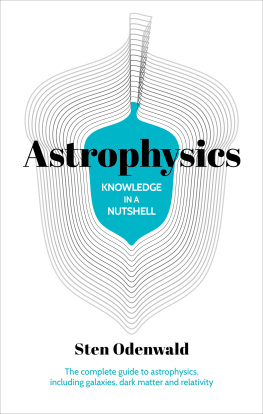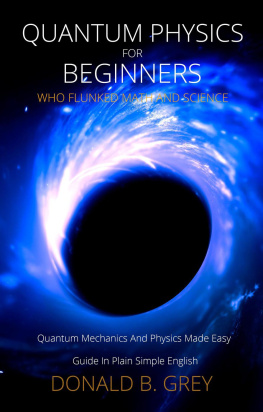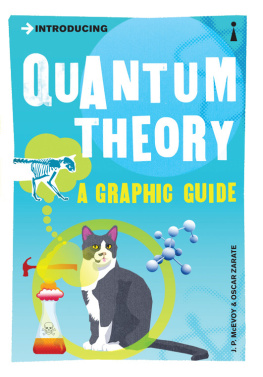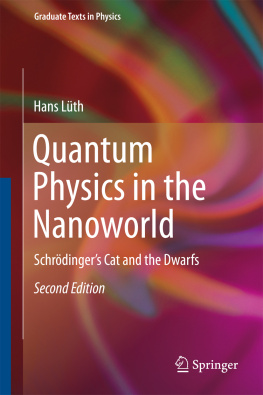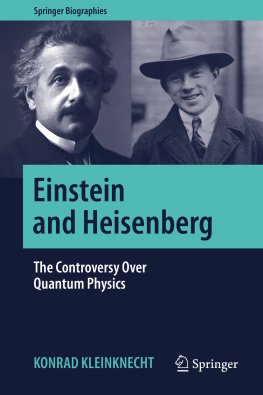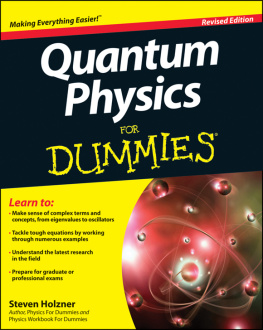Introduction
Quantum physics is perhaps one of the most challenging and mind-numbing subjects in all of physics. It is widely understood by physicists themselves as one of the deepest subjects in the scientific study of our physical world. Even Richard Feynman, noted that I think it is safe to say that no one understands quantum mechanics. Do not keep saying to yourself, if you can possibly avoid it, but how can it be like that? because you will go down the drain into a blind alley from which nobody has yet escaped. Nobody knows how it can be like that.
This book will try to describe the highlights of this deep understanding of matter and forces starting from the Atomist School of ancient Greece through the most advanced, current experiments on the nature of matter. The plethora of books that present quantum mechanics in a popular writing style bespeak a reoccurring fascination with this topic, and there are many different styles to choose from. This has been a great benefit to the novice who is trying to obtain a snapshot of the key issues and discoveries in this field. Because quantum physics is an evolving subject that benefits every year from new experimental studies, it is most certainly important to update the public discussion of this field. Even books written as little as five years ago are out-of-date in certain key areas of investigation, most notably in the areas of string theory, quantum gravity and issues of quantum measurement.
Unlike most other areas in science, physics can only be expressed accurately in mathematical terms. I will avoid the extravagant use of mathematical equations, and the very few that are presented should be regarded as paintings in an art museum to be admired for their form much as one might admire a painting without delving deeply into its subject matter or the artists paintbrush strokes. The compromise, however, is that numerical information may in some instances be calculated to show how it is done and to set the scale for the phenomena being described.
Quantum physics also uses a plethora of terminology that are often intimidating to the non-physicist. Unfortunately it is impossible to write about quantum physics without mentioning wave functions, fermions and the many terms such as SU(3) that have appeared in the subject areas of Grand Unification Theory and quantum measurement. There is no good solution to how to discuss important concepts without mentioning the specific objects being described, so the reader is encouraged to consider these terms when they appear as proper names such as Steven or Mary that themselves require no further definition.
The entire rubric of quantum physics, which will be described in this book in some detail, can be distilled into a small list of conclusions about the physical world, which I attempt to summarize at the end of each chapter. Each of these conclusions are in themselves worthy of deep contemplation and lead to a dramatic transformation in the way we must view our physical world. The atomic matter from which our universe is built does not have a definite property to it until the instant of observation or measurement, and changes instantaneously between a particle and a wave-like description depending on the experimental question being asked. What we consider to be empty space as a vacuum is an illusion, as are the very natures of time and space. Finally, the ingredients to the universe behave in some sense as though they require the act of observation to bring them into existence. Finally, the indeterminacy of the quantum description to the atomic world is not an artefact of missing information that could be provided by some new, larger theory of the world. After only 100 years of investigation and experimentation, we are only a bit further ahead in understanding why the world is built the way it is. Nevertheless, what we have learned by 2019 most assuredly sets the stage for entirely new investigations in the years to come.
Chapter 1
The Dawn of Atomic Physics
The idea that the things around us, such as rocks, air and water, are themselves made from other ingredients more elementary than the physical world visible to us is one that was long in coming. From the dawn of the written word fashioned from Sumerian cuneiform, Egyptian hieroglyphics, or even ancient Chinese pictograms there is scarcely a hint that our very distant ancestors considered such ideas noteworthy. Of course, humans at all times could distinguish among the many diverse substances: from rocky compounds and elementary gold to the bewildering variety of biological matter in trees, plants and animals. But the idea that there were still more elementary substances behind the ones we commonly see was inconceivable. So far as recorded history can tell us, this all changed during the last few centuries bce , when ancient Indian philosophers and ancient Greek proto-scientists came up with the idea of the smallest particles of matter. The Indian idea is credited to Acharya Kanad, who lived sometime between the 6th and 2nd centuries bce in Prabhas Kshetra (near Dwaraka) in Gujarat, India. Beginning with grains of rice, he developed the idea of the smallest particles of matter, which he later called Parmanu. Kanad later founded the Vaisheshika school of philosophy, where he taught his ideas about the atom and the nature of the universe. Virtually identical ideas about the nature of matter were developed, either independently or by the natural diffusion of ideas, by the ancient Greeks.
The Atomic Universe
The theory of Atoms (from the Greek , atomos, meaning indivisible), proposed by Democritus and Leucippus in the 5th century bce was a dramatic departure from prevailing ideas around the Mediterranean and in the Far East, in which matter was a continuum characterized by a handful of distinct properties. The Atomists made the innovative proposal that there were an infinite number of atoms varying in shape, and that these shapes determined the properties of the matter they combined to create. For example, iron atoms had tiny hooks that linked together at room temperature, making it a strong solid. Atoms were so small they could not be seen, and like marbles in a half-empty box, they could rearrange themselves to form new substances.

Democritus and Leucippus developed the ancient Greek idea of the atom.
This meant that in addition to atoms there must also exist a completely empty Void, otherwise these atoms would be locked together into a vast immovable mass for eternity. Only the Void made atoms a workable construct, and so from this time forward, the properties of empty space and atoms were intimately linked together. In 55 bce , Lucretius, in his On the Nature of Things, described the shapes of atoms as follows:
Since atoms are what they are by nature, and not cut by hand to a single predetermined pattern, some of them must have shapes unlike some others. By reasoning, we may readily comprehend why lightning-fire is much more penetrating than ours that comes from torches here on earth. Or one may say that the lightning fire is finer and made in smaller shapes, and thus can pass through opening that our fire cannot, spring as it is of wood and torch. Things which are hard and dense must be composed of particles hooked and barbed and branch-like, intertwined and tightly gripped.
(Lucretius, Epicurean and Poet, by John Masson 1907)
Meanwhile, several hundred years after the Atomists established their fledgling school of thought in the West, Aristotle (384322 bce ) espoused the existence of only five essences: Earth, Air, Fire, Water and Aether. In fact, he found the idea of the Atomists empty Void abhorrent, and as one of the most influential philosophers of his time he was able to mount many criticisms of the Atomists school. Relatively quickly the theory of Atoms went into eclipse as a theory of matter. Nevertheless, by the 2nd century ce , alchemists, metallurgists and jewellers knew of a great number of elemental species of Aristotles Earth element and recognized that some of these, such as gold, were unable to mix with other compounds, making them more elementary than other forms of Earth. There were strong dividing lines between what the Aristotelian theoreticians were saying, and what was known by alchemists experimentally. By the 14th century, there was a revival of interest in the Atomist school of thought, but because atomism was associated with the philosophy of Epicureanism, which contradicted orthodox Christian teachings, belief in atoms was not considered acceptable.


